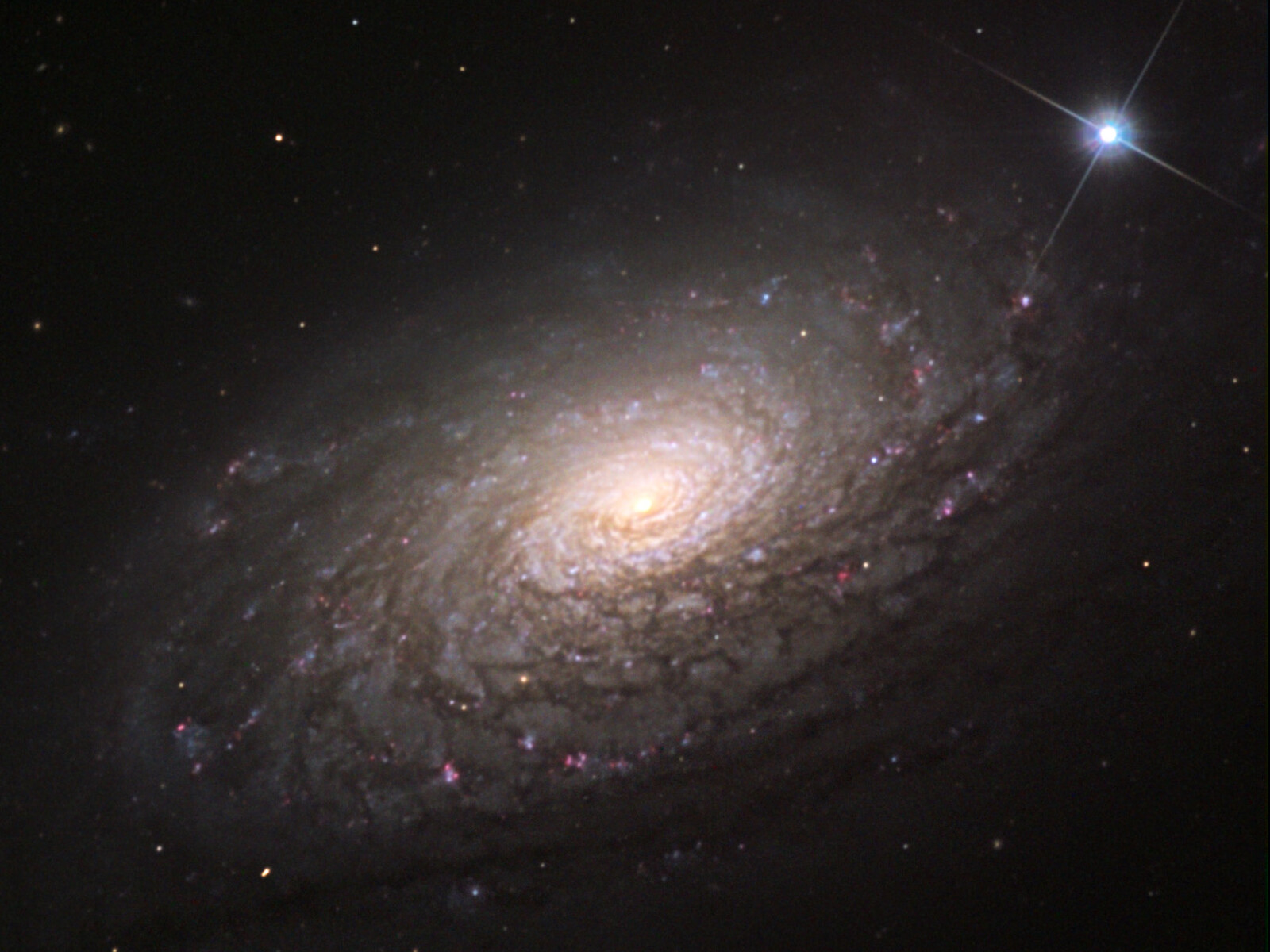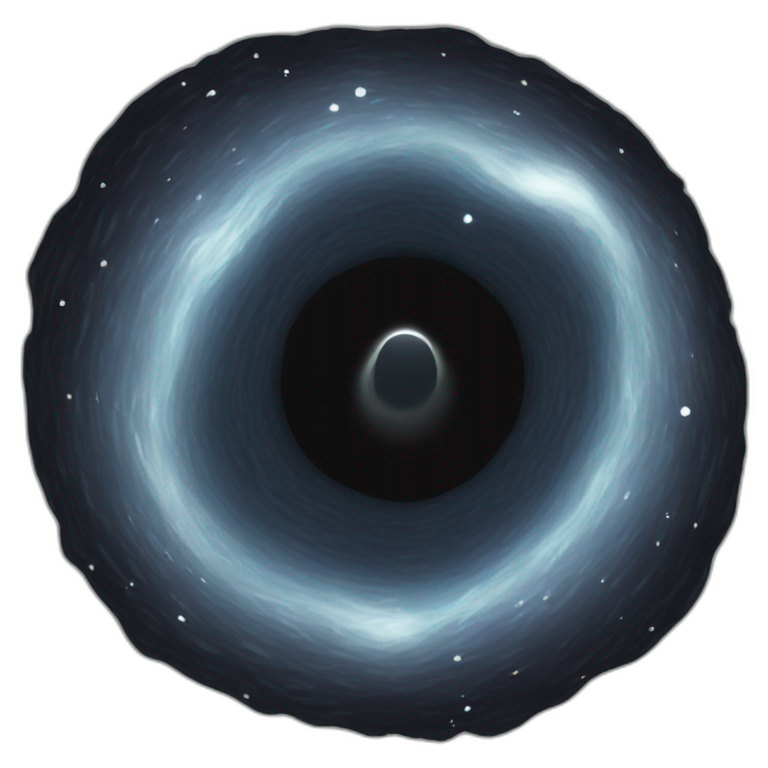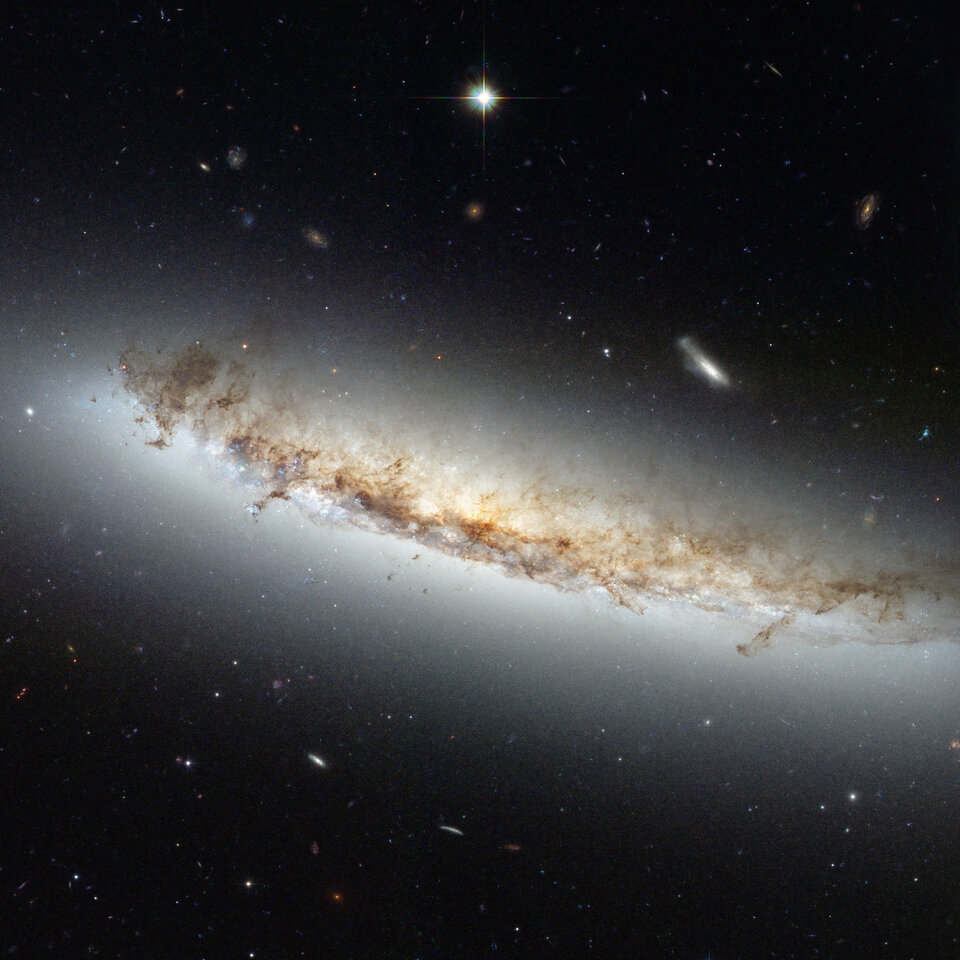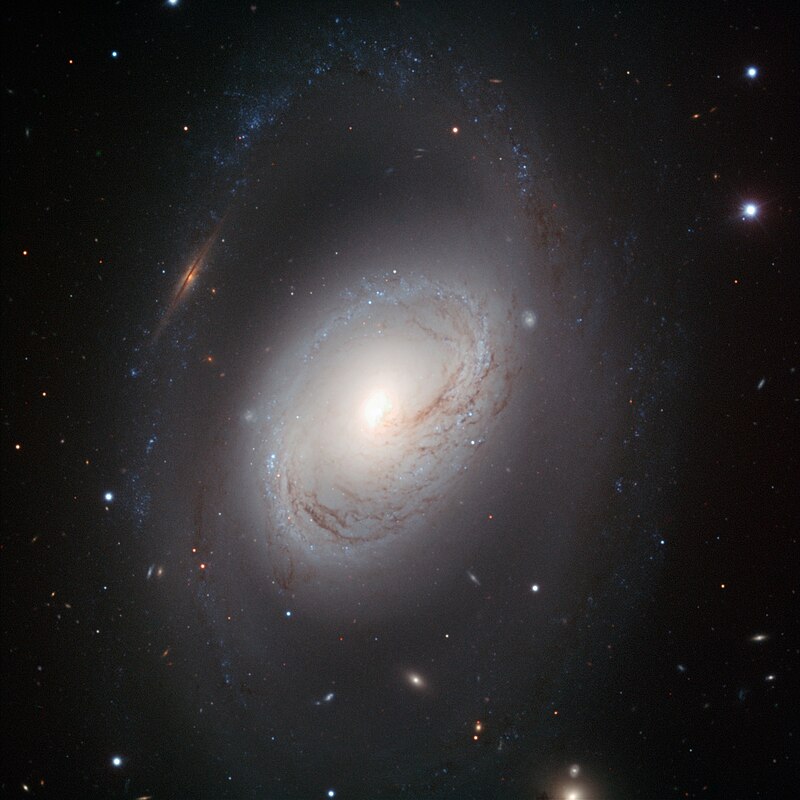Page 1 of 1
APOD: Hubble's NGC 1546 (2024 Jun 21)
Posted: Fri Jun 21, 2024 4:05 am
by APOD Robot
 Hubble's NGC 1546
Explanation: Returning to science operations
Hubble's NGC 1546
Explanation: Returning to science operations on June 14, the Hubble Space Telescope used its new
pointing mode to capture this sharp image of
spiral galaxy NGC 1546. A member of the
Dorado galaxy group, the island universe lies a mere 50 million light-years away. The galactic disk of NGC 1546 is tilted to our line-of-sight, with the yellowish light of the old stars and bluish regions of newly formed stars shining through the galaxy's dust lanes. More distant background galaxies are scattered throughout this Hubble view. Launched in 1990, Hubble has been
exploring the cosmos for more than three decades, recently celebrating its 34th anniversary.
Re: APOD: Hubble's NGC 1546 (2024 Jun 21)
Posted: Fri Jun 21, 2024 4:40 am
by shaileshs
Sorry, tangential thought that is top of my mind looking at the photo.. Those "direction" arrows.. I've always wondered how and why someone would feel/decide - and obviously I'm assuming the whole scientist community agreed to - a specific direction as North/East/South/West.. When someone can feel exactly opposite or any which way different and all would be correct. Feels strange when we know there's nothing like real north/east/south/west directions in continuous uniform 360deg universe/cosmos.. Feels a bit forced, just for our convenience.. again, just a passing thought..
Re: APOD: Hubble's NGC 1546 (2024 Jun 21)
Posted: Fri Jun 21, 2024 4:44 am
by Chris Peterson
shaileshs wrote: ↑Fri Jun 21, 2024 4:40 am
Sorry, tangential thought that is top of my mind looking at the photo.. Those "direction" arrows.. I've always wondered how and why someone would feel/decide - and obviously I'm assuming the whole scientist community agreed to - a specific direction as North/East/South/West.. When someone can feel exactly opposite or any which way different and all would be correct. Feels strange when we know there's nothing like real north/east/south/west directions in continuous uniform 360deg universe/cosmos.. Feels a bit forced, just for our convenience.. again, just a passing thought..
Do you also think there's no meaning to those terms on the Earth? Positions in the sky are defined by a very similar system, with the north celestial pole above Earth's north pole, the celestial equator co-planar with Earth's equator, and the south celestial pole above Earth's south pole. So cardinal directions make perfect sense. Right ascension equates to longitude (so east and west) and declination to latitude (north and south).
There are other coordinate systems used for astronomical objects, but since we observe from Earth, this one is the most convenient. For us, of course. Who else?
Re: APOD: Hubble's NGC 1546 (2024 Jun 21)
Posted: Fri Jun 21, 2024 5:26 am
by AVAO
APOD Robot wrote: ↑Fri Jun 21, 2024 4:05 am
 Hubble's NGC 1546
Explanation: Returning to science operations
Hubble's NGC 1546
Explanation: Returning to science operations on June 14, the Hubble Space Telescope used its new
pointing mode to capture this sharp image of
spiral galaxy NGC 1546. A member of the
Dorado galaxy group, the island universe lies a mere 50 million light-years away. The galactic disk of NGC 1546 is tilted to our line-of-sight, with the yellowish light of the old stars and bluish regions of newly formed stars shining through the galaxy's dust lanes. More distant background galaxies are scattered throughout this Hubble view. Launched in 1990, Hubble has been
exploring the cosmos for more than three decades, recently celebrating its 34th anniversary.
Hmmm. I'm amazed at how well Euclid can keep up with Hubble here.
Original data: NASA/ESA (Euclid) jac berne (flickr)
Re: APOD: Hubble's NGC 1546 (2024 Jun 21)
Posted: Fri Jun 21, 2024 5:48 am
by Ann
Today's APOD is a nice image, and I'm very glad indeed that Hubble is back in action!
NGC 1546 reminds me somewhat of M63 because of its inclination and its small scattered clusters and thick dust lanes:
But wait, there is something wrong with the comparison of NGC 1546 to M63. Why does the dust of NGC 1546 look so turbulent? It looks like dozens or more of smoking chimneys



are rising from the disk. Even though there are a few smoking chimneys in M63 too, on the whole M63 looks nothing like that. What's going on with NGC 1546?
Could there be more of NGC 1546 than meets the eye in the Hubble picture? Indeed there is!
As you can see, NGC 1546 has a huge massive halo that dwarfs the inner disk within. So, rather than NGC 1546 reminding me of spiral galaxy M63, it reminds me (at least slightly) of the inner gas disk of giant elliptical galaxy M87 (the galaxy with the tremendous central black hole, you know?).
I'm also slightly reminded of the violent starburst in the very central part of spiral galaxy NGC 1808:
However, both the inner gas disk of M87 and the central starburst region of NGC 1808 are very small compared with the overall sizes of these two galaxies. The turbulent disk of gas and dust in NGC 1546 is relatively large compared with the galaxy as a whole.
Still, my explanation for the turbulent nature of the disk of NGC 1546 is that it is caused by the galaxy's central black hole acting up,
or (more likely) the chimneys are remnants of many violent supernovas that followed after a giant burst of star formation in this galaxy's disk.








But wait! There is a third possibility. Maybe NGC 1546 is a ram pressure stripping galaxy? Maybe it is falling through intergalactic space and losing gas as it is falling? Like NGC 4402, which is falling through the intergalactic medium of the Virgo Cluster?
So, hypotheses, hypotheses. Let me end with a look at that lovely little perfectly edge-on background galaxy:
Let's see, where have I seen such a lovely little edge-on background galaxy cosying up to a foreground galaxy before? Oh yes! In the Hubble image of M96:
Gorgeous, isn't it?

Ann
Re: APOD: Hubble's NGC 1546 (2024 Jun 21)
Posted: Fri Jun 21, 2024 12:10 pm
by Roy
Awe-inspiringly explicated, Ann!
Re: APOD: Hubble's NGC 1546 (2024 Jun 21)
Posted: Fri Jun 21, 2024 1:49 pm
by FrankTKO
Looking at the scale, it looks like NGC 1546 is quite small, no? How small can a spiral galaxy be?
Re: APOD: Hubble's NGC 1546 (2024 Jun 21)
Posted: Fri Jun 21, 2024 2:04 pm
by Holger Nielsen
It has been said of the brilliant Indian mathematician Ramanujan that every natural number, for instance 1729, was a friend of his (If you have not heard of him, look him up in
Wikipedia ).
Likewise, it seems to me that every galaxy in the Messier and NGC catalogues is a friend of Ann.

Re: APOD: Hubble's NGC 1546 (2024 Jun 21)
Posted: Fri Jun 21, 2024 2:11 pm
by Chris Peterson
FrankTKO wrote: ↑Fri Jun 21, 2024 1:49 pm
Looking at the scale, it looks like NGC 1546 is quite small, no? How small can a spiral galaxy be?
This looks to be 40-50K ly across, which is pretty typical for spiral galaxies. Maybe a bit on the low end, but not unusual. FWIW, this isn't a spiral galaxy, but a lenticular galaxy. We might compare it with the Sombrero Galaxy, which is similarly intermediate between elliptical and spiral, and about the same size.
Re: APOD: Hubble's NGC 1546 (2024 Jun 21)
Posted: Fri Jun 21, 2024 4:21 pm
by nucmedtech
I was musing on the world of 1990, when Hubble was launched. The telescope has outlived much of its contemporary technology. Cassette tapes and CDs, pay phones and landlines, huge actually floppy floppy discs and their 3.5" counterparts, loud squawky modems and dialup internet have all gone the way of the dodo. Cellphones have evolved from large handsets or car models in bags with curly antennas to be pocket computers more powerful than anything we could have hoped to have on our desks in 1990. It's just amazing that Hubble is still acquiring scientifically-relevant images and information all these years later.
Re: APOD: Hubble's NGC 1546 (2024 Jun 21)
Posted: Fri Jun 21, 2024 4:39 pm
by Chris Peterson
nucmedtech wrote: ↑Fri Jun 21, 2024 4:21 pm
I was musing on the world of 1990, when Hubble was launched. The telescope has outlived much of its contemporary technology. Cassette tapes and CDs, pay phones and landlines, huge actually floppy floppy discs and their 3.5" counterparts, loud squawky modems and dialup internet have all gone the way of the dodo. Cellphones have evolved from large handsets or car models in bags with curly antennas to be pocket computers more powerful than anything we could have hoped to have on our desks in 1990. It's just amazing that Hubble is still acquiring scientifically-relevant images and information all these years later.
CDs remain the best distribution medium for music, and landlines are still essential if you require reliability and good voice quality! Neither have disappeared!
Re: APOD: Hubble's NGC 1546 (2024 Jun 21)
Posted: Fri Jun 21, 2024 6:34 pm
by johnnydeep
So once again the brilliant engineers at NASA have managed to make the most of the situation by compensating for failing hardware. I didn't quite understand from the links how using only one gyroscope instead of the full complement of four compromises accuracy or other capability. Does it affect things much?
Re: APOD: Hubble's NGC 1546 (2024 Jun 21)
Posted: Fri Jun 21, 2024 6:49 pm
by Ann
Roy wrote: ↑Fri Jun 21, 2024 12:10 pm
Awe-inspiringly explicated, Ann!
Thanks, Roy!

Ann
Re: APOD: Hubble's NGC 1546 (2024 Jun 21)
Posted: Fri Jun 21, 2024 6:50 pm
by Ann
Holger Nielsen wrote: ↑Fri Jun 21, 2024 2:04 pm
It has been said of the brilliant Indian mathematician Ramanujan that every natural number, for instance 1729, was a friend of his (If you have not heard of him, look him up in
Wikipedia ).
Likewise, it seems to me that every galaxy in the Messier and NGC catalogues is a friend of Ann.

Thanks, Holger! Yes, I do indeed consider myself a galaxy girl. Even though I obviously know - make that visually recognize - just a small fraction all the thousands of galaxies in the NGC catalog. NGC 1546, for example, was unknown to me before I saw this new Hubble image of that galaxy.
Ann
Re: APOD: Hubble's NGC 1546 (2024 Jun 21)
Posted: Sun Jun 23, 2024 3:30 pm
by ksimon53
How is it that when looking north, east is to your left? Not on any compass I've ever seen. Is this photo a mirror-reversed image?
Re: APOD: Hubble's NGC 1546 (2024 Jun 21)
Posted: Sun Jun 23, 2024 3:31 pm
by ksimon53
How is it that when looking north, east is to your left? Not on any compass I've ever seen. Is this photo a mirror-reversed image?
Re: APOD: Hubble's NGC 1546 (2024 Jun 21)
Posted: Sun Jun 23, 2024 3:55 pm
by Chris Peterson
ksimon53 wrote: ↑Sun Jun 23, 2024 3:30 pm
How is it that when looking north, east is to your left? Not on any compass I've ever seen. Is this photo a mirror-reversed image?
If you lay on the ground, with your head to the north, east is to your left. Stellar coordinates mirror terrestrial coordinates because instead of being drawn on the outside of a sphere (the Earth) they are drawn on the inside of a sphere (the sky).
Re: APOD: Hubble's NGC 1546 (2024 Jun 21)
Posted: Sun Jun 23, 2024 4:07 pm
by johnnydeep
Chris Peterson wrote: ↑Sun Jun 23, 2024 3:55 pm
ksimon53 wrote: ↑Sun Jun 23, 2024 3:30 pm
How is it that when looking north, east is to your left? Not on any compass I've ever seen. Is this photo a mirror-reversed image?
If you lay on the ground, with your head to the north, east is to your left. Stellar coordinates mirror terrestrial coordinates because instead of being drawn on the outside of a sphere (the Earth) they are drawn on the inside of a sphere (the sky).
Perfect, cogent explanation! Even I understand it.

Re: APOD: Hubble's NGC 1546 (2024 Jun 21)
Posted: Sun Jun 23, 2024 5:33 pm
by Ann
Chris Peterson wrote: ↑Sun Jun 23, 2024 3:55 pm
ksimon53 wrote: ↑Sun Jun 23, 2024 3:30 pm
How is it that when looking north, east is to your left? Not on any compass I've ever seen. Is this photo a mirror-reversed image?
If you lay on the ground, with your head to the north, east is to your left. Stellar coordinates mirror terrestrial coordinates because instead of being drawn on the outside of a sphere (the Earth) they are drawn on the inside of a sphere (the sky).
As a kid I was told this mnemonic to tell the cardinal points apart:
"Your nose to the north
the Sun in the south
East to your right
and west to your left."
Why doesn't this mnemonic work when you look up at the night sky? It's because in Chris' example,
you lay down on your back.
Try laying down on your tummy, and east will be to your right and west to your left, like we expect it to be here on Earth.
But it will be awfully uncomfortable to crank your head back far enough to observe the sky from that position.
Ann
Re: APOD: Hubble's NGC 1546 (2024 Jun 21)
Posted: Mon Jul 01, 2024 6:16 pm
by CuriousChimp
There are fairly good theoretical engineering designs for space-craft, mainly City-farms with sustainable populations of inhabitants - "generation ships" - that could travle at speeds ranging up to one tenth of the speed of light.
At that incredible speed, this galaxy is "
only" a mere five hundred million years away.
Had we started well before the dinosaurs walked the planet, we could be arriving about now.
Of course, there are also valid reasons for thinking that friction with the interstellar gas and dust would restrict speeds in real space to less than one hundredth of the speed of light no matter how good our engineering is.
If that is so, then this galaxy is five
thousand million years away and to arrive now we would have had to start our journey before the Sun was born.
Re: APOD: Hubble's NGC 1546 (2024 Jun 21)
Posted: Mon Jul 01, 2024 6:24 pm
by Chris Peterson
CuriousChimp wrote: ↑Mon Jul 01, 2024 6:16 pm
There are fairly good theoretical engineering designs for space-craft, mainly City-farms with sustainable populations of inhabitants - "generation ships" - that could travle at speeds ranging up to one tenth of the speed of light.
At that incredible speed, this galaxy is "
only" a mere five hundred million years away.
Had we started well before the dinosaurs walked the planet, we could be arriving about now.
Of course, there are also valid reasons for thinking that friction with the interstellar gas and dust would restrict speeds in real space to less than one hundredth of the speed of light no matter how good our engineering is.
If that is so, then this galaxy is five
thousand million years away and to arrive now we would have had to start our journey before the Sun was born.
Of course, assuming technology to shield the ship from collisions with interstellar matter, the time it takes to get there (in theory) can be arbitrarily short (subject, as well, to the G-force limitations on whatever is inside the ship). Arbitrarily short from the reference frame of the ship, that is. Hope the crew doesn't plan on seeing any family or friends when they get back, though. Or maybe not even any humans!
Re: APOD: Hubble's NGC 1546 (2024 Jun 21)
Posted: Mon Jul 01, 2024 6:57 pm
by CuriousChimp
Chris Peterson wrote: ↑Mon Jul 01, 2024 6:24 pm
CuriousChimp wrote: ↑Mon Jul 01, 2024 6:16 pm
There are fairly good theoretical engineering designs for space-craft, mainly City-farms with sustainable populations of inhabitants - "generation ships" - that could travle at speeds ranging up to one tenth of the speed of light.
At that incredible speed, this galaxy is "
only" a mere five hundred million years away.
Had we started well before the dinosaurs walked the planet, we could be arriving about now.
Of course, there are also valid reasons for thinking that friction with the interstellar gas and dust would restrict speeds in real space to less than one hundredth of the speed of light no matter how good our engineering is.
If that is so, then this galaxy is five
thousand million years away and to arrive now we would have had to start our journey before the Sun was born.
Of course, assuming technology to shield the ship from collisions with interstellar matter, the time it takes to get there (in theory) can be arbitrarily short (subject, as well, to the G-force limitations on whatever is inside the ship). Arbitrarily short from the reference frame of the ship, that is. Hope the crew doesn't plan on seeing any family or friends when they get back, though. Or maybe not even any humans!
True enough, given SF-levels of engineering.
With 0.01 to 0.1 C being the fastest a realistic vessel can move in the real univese, given the limits of real engineering, relativistic tiime compression inside the vessel isn't much of a factor.
And you're entirely correct about the travellers not having great hopes of sending a postcard back to Cousin Suzy. After 10,000,000,000 years, assuming the mail ship isn't much faster than the habitat, Cousin Suzy would have evolved a little. Even with a laser communications system built withing a few millennia after they arrive, the stay-at-homes would be unlikely to be even remotely human.
As, indeed, would the travellers.
It would also be unlikely for the newly arrived travellers to care about Earth. We don't even know much about our ancestors a few millennia ago. Over millions of years the fog of loss would obscure almost everything once known and remembered.
The guys in the new galaxy wouldn't be "us".
Re: APOD: Hubble's NGC 1546 (2024 Jun 21)
Posted: Mon Jul 01, 2024 7:07 pm
by Chris Peterson
CuriousChimp wrote: ↑Mon Jul 01, 2024 6:57 pm
Chris Peterson wrote: ↑Mon Jul 01, 2024 6:24 pm
CuriousChimp wrote: ↑Mon Jul 01, 2024 6:16 pm
There are fairly good theoretical engineering designs for space-craft, mainly City-farms with sustainable populations of inhabitants - "generation ships" - that could travle at speeds ranging up to one tenth of the speed of light.
At that incredible speed, this galaxy is "
only" a mere five hundred million years away.
Had we started well before the dinosaurs walked the planet, we could be arriving about now.
Of course, there are also valid reasons for thinking that friction with the interstellar gas and dust would restrict speeds in real space to less than one hundredth of the speed of light no matter how good our engineering is.
If that is so, then this galaxy is five
thousand million years away and to arrive now we would have had to start our journey before the Sun was born.
Of course, assuming technology to shield the ship from collisions with interstellar matter, the time it takes to get there (in theory) can be arbitrarily short (subject, as well, to the G-force limitations on whatever is inside the ship). Arbitrarily short from the reference frame of the ship, that is. Hope the crew doesn't plan on seeing any family or friends when they get back, though. Or maybe not even any humans!
True enough, given SF-levels of engineering.
With 0.01 to 0.1 C being the fastest a realistic vessel can move in the real univese, given the limits of real engineering, relativistic tiime compression inside the vessel isn't much of a factor.
And you're entirely correct about the travellers not having great hopes of sending a postcard back to Cousin Suzy. After 10,000,000,000 years, assuming the mail ship isn't much faster than the habitat, Cousin Suzy would have evolved a little. Even with a laser communications system built withing a few millennia after they arrive, the stay-at-homes would be unlikely to be even remotely human.
As, indeed, would the travellers.
It would also be unlikely for the newly arrived travellers to care about Earth. We don't even know much about our ancestors a few millennia ago. Over millions of years the fog of loss would obscure almost everything once known and remembered.
The guys in the new galaxy wouldn't be "us".
It takes no more than a hundred million years or so to completely explore the entire galaxy, every star, every planet. And not particularly advanced technology to do so. Begging the question... why hasn't that happened?
Re: APOD: Hubble's NGC 1546 (2024 Jun 21)
Posted: Tue Jul 02, 2024 7:13 am
by Ann
Chris Peterson wrote: ↑Mon Jul 01, 2024 7:07 pm
CuriousChimp wrote: ↑Mon Jul 01, 2024 6:57 pm
Chris Peterson wrote: ↑Mon Jul 01, 2024 6:24 pm
Of course, assuming technology to shield the ship from collisions with interstellar matter, the time it takes to get there (in theory) can be arbitrarily short (subject, as well, to the G-force limitations on whatever is inside the ship). Arbitrarily short from the reference frame of the ship, that is. Hope the crew doesn't plan on seeing any family or friends when they get back, though. Or maybe not even any humans!
True enough, given SF-levels of engineering.
With 0.01 to 0.1 C being the fastest a realistic vessel can move in the real univese, given the limits of real engineering, relativistic tiime compression inside the vessel isn't much of a factor.
And you're entirely correct about the travellers not having great hopes of sending a postcard back to Cousin Suzy. After 10,000,000,000 years, assuming the mail ship isn't much faster than the habitat, Cousin Suzy would have evolved a little. Even with a laser communications system built withing a few millennia after they arrive, the stay-at-homes would be unlikely to be even remotely human.
As, indeed, would the travellers.
It would also be unlikely for the newly arrived travellers to care about Earth. We don't even know much about our ancestors a few millennia ago. Over millions of years the fog of loss would obscure almost everything once known and remembered.
The guys in the new galaxy wouldn't be "us".
It takes no more than a hundred million years or so to completely explore the entire galaxy, every star, every planet. And not particularly advanced technology to do so. Begging the question... why hasn't that happened?
Because we are "it"? We are the technological civilization of the Milky Way?
Because we are the first, or because the other technological civilizations of the Milky Way destroyed themselves before they were ready to send probes around the galaxy?
Ann
Re: APOD: Hubble's NGC 1546 (2024 Jun 21)
Posted: Tue Jul 02, 2024 12:49 pm
by Chris Peterson
Ann wrote: ↑Tue Jul 02, 2024 7:13 am
Chris Peterson wrote: ↑Mon Jul 01, 2024 7:07 pm
CuriousChimp wrote: ↑Mon Jul 01, 2024 6:57 pm
True enough, given SF-levels of engineering.
With 0.01 to 0.1 C being the fastest a realistic vessel can move in the real univese, given the limits of real engineering, relativistic tiime compression inside the vessel isn't much of a factor.
And you're entirely correct about the travellers not having great hopes of sending a postcard back to Cousin Suzy. After 10,000,000,000 years, assuming the mail ship isn't much faster than the habitat, Cousin Suzy would have evolved a little. Even with a laser communications system built withing a few millennia after they arrive, the stay-at-homes would be unlikely to be even remotely human.
As, indeed, would the travellers.
It would also be unlikely for the newly arrived travellers to care about Earth. We don't even know much about our ancestors a few millennia ago. Over millions of years the fog of loss would obscure almost everything once known and remembered.
The guys in the new galaxy wouldn't be "us".
It takes no more than a hundred million years or so to completely explore the entire galaxy, every star, every planet. And not particularly advanced technology to do so. Begging the question... why hasn't that happened?
Because we are "it"? We are the technological civilization of the Milky Way?
Because we are the first, or because the other technological civilizations of the Milky Way destroyed themselves before they were ready to send probes around the galaxy?
Ann
I incline toward the latter.
 Hubble's NGC 1546
Hubble's NGC 1546











